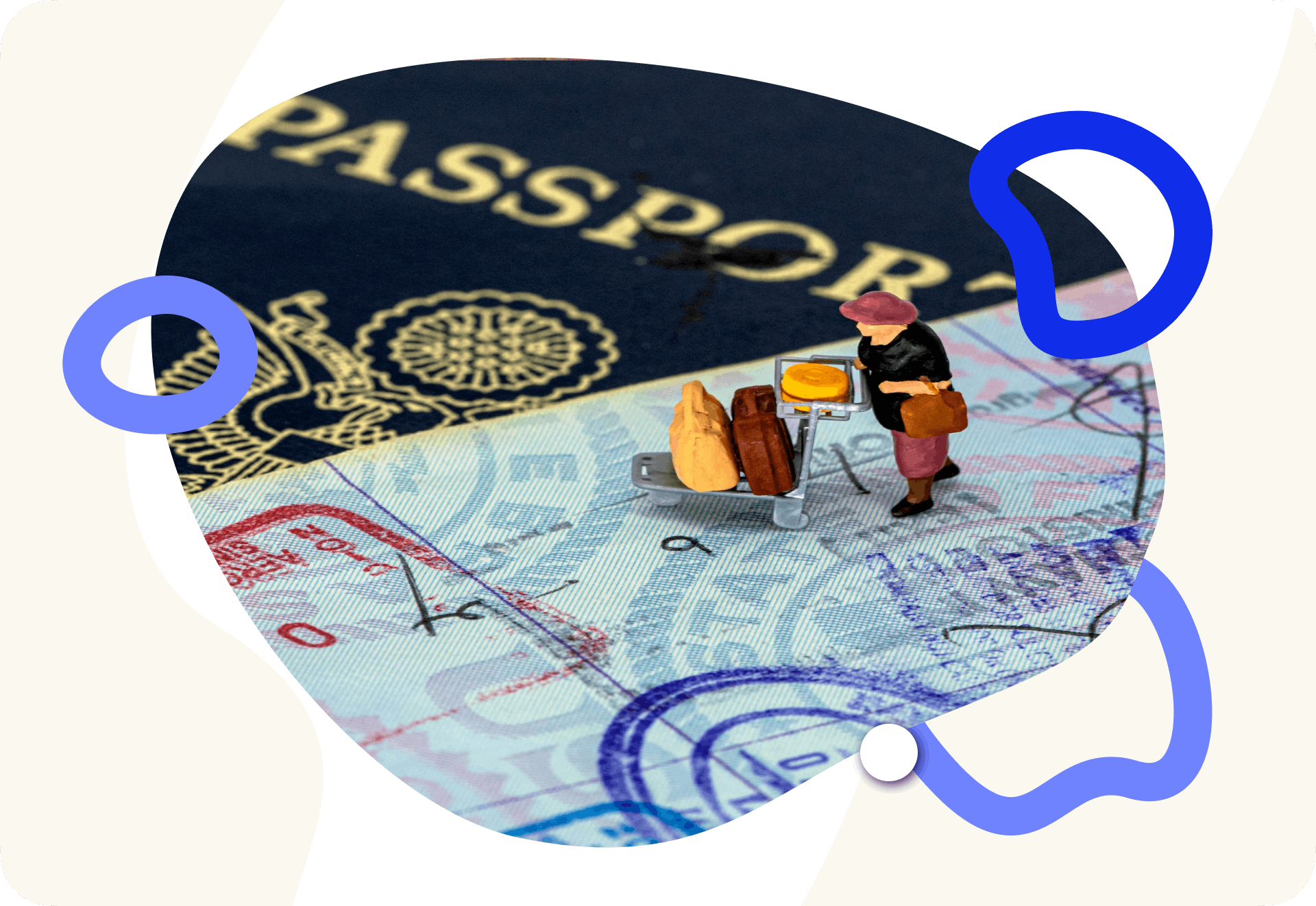Table of contents
- What is a visa?
- What does a visa look like?
- History of visas
- Types of visas
- Applying for a visa
- Required documents
- Fees
- Preparing for the visa interview
- What is a passport?
- How do visas differ from passports?
- Other work visa application matters
If you're looking to hire foreign talent or relocate current employees, you must follow specific visa requirements. These requirements vary by country and type of visa. Read on to discover how to optimize the visa application for your employee's relocation across various scenarios.
What is a visa?
A visa is an official document your hired talent may need to enter a country legally. Visa rules depend on your employee's nationality and their destination country. However, these rules may change based on updated immigration laws. We recommend staying informed about a country's latest visa regulations to ensure a smooth travel or relocation process.
Visas are usually mandatory for work purposes, but some countries may follow policies allowing foreign nationals to travel without a visa under certain circumstances. This rule is often limited to tourism and short-term business not intended for long-term gainful employment.
What does a visa look like?
A visa is a document that customs officers stamp, glue, or otherwise attach to a passport. A bearer's visa document contains personal travel information that might include your employee's:
- Country of birth
- Passport identification number
- Unique visa number
- Visa issue and expiry date
- Visa holder’s nationality
- Number of entries allowed to their destination country
History of visas
The earliest visas were cross-border documentation for traveling merchants and traders. However, the modern concept of travel visas originateds in Britain during the 19th century.
Specifically, the UK passed the British Aliens Act in 1905, which placed immigration controls and restrictive measures to safeguard borders. Visa documents gradually arose from the Aliens Act as a way to qualify immigrants and travelers. These documents helped validate travel purposes and eased the competition for local resources, housing, and other provisions.
The international passport conferences of the 1920s led to more standardized documentation and visa regulations. After the Second World War, bilateral agreements between nations fine-tuned the visa concept to promote peace and stability across borders. These government coalitions led to various visa categorizations (such as work and tourism) for more structured immigration practices.
Intelligent digital technologies in the 21st century led to e-visas that simplified and accelerated visa applications and international travel. These visa improvements align with the demands of tourism economies and the global workforce, significantly reducing traditional bureaucracies and long processing times.
Types of visas
Different visa types provide bearers with separate rights according to their type of stay in a foreign country. We share some of the most common types of visas, including those you'd likely consider for your employees' corporate relocation.
Non-immigrant visas
Certain countries, such as the United States, issue non-immigrant visas to travelers. These visas cater to individuals with permanent residence outside the country who wish to stay temporarily, such as for overseas job attachments. A country might further divide the classification by the bearer's role or purpose of stay. For example, there are visas for temporary agricultural workers, visiting academics, and athletes.
The US offers a range of non-immigrant visas, including the D-visa for visiting crew members from airlines and cruises. Some nationalities may also qualify for exclusive non-immigrant visas based on the bilateral relationships and agreements between countries. For instance, the H-1B visa enables people from Singapore and Chile, among others, to work as professionals and bring their spouses and dependent children for their temporary relocation.
Immigrant visas
These visas apply to individuals intending to relocate to a country permanently. Applicants of immigrant visas go through additional processes, such as detailed background checks, financial assessments, and medical history, due to the long-term validity.
For instance, Spain's D-visas let non-EU passport bearers study and work for an extended period. They come in one-, three-, and five-year categories. These are accumulative visas, and securing the 5-year D-visa is an effective method of emigrating into the country.
Work visas
A work visa typically gives someone the legal right to pursue employment or long-term business activities. It's important to check each country's work visa options as they determine the type of jobs and career arrangements allowed.
For example, Albania, Spain, Portugal, Estonia and a few other countries provide digital nomad visas that let people work during their stay. The criteria for a temporary work visa may differ, especially regarding monthly income (to prove that someone has the finances to manage expenses). Most digital nomad visas also prohibit bearers from working with local employers.
Countries like Germany have become increasingly popular as corporate relocation and migration destinations, potentially due to the country's broad work visa options and job prospects. The EU Blue Card is one specialty visa Germany offers. This visa is for highly qualified employees with a German or comparable foreign academic degree or equivalent qualification.
Transit visas
Sometimes, travelers must apply for a transit visa if they're physically in a stopover country for more than five hours before moving to the destination country. The United States has this requirement and issues non-immigrant C-1 transit visas. These visas authorize entry for travelers with layovers at a US airport en route to their host country.
Tourist visas
Individuals entering a foreign country for travel or leisure purposes must apply for a tourist or traveler visa. For instance, Germany's Schengen tourist/visitor visa enables bearers to visit Germany and 26 other member states within the Schengen area. Recipients must have no intentions of studying or working during their stay.
Applying for a visa
The visa application process varies by country. While some nations offer a straightforward application process, others may require additional steps, such as health examinations and interviews. Also, depending on the country, the applied visa might authorize single-use or multiple entries.
Below are the standard visa application steps to help guide your employees through a frictionless application process.
Identify the type of visa required
Your first step is to shortlist the most suitable visa option. Visit the country's official immigration website for a complete list of available visas, or work with a relocation expert like Localyze. You should also check the eligibility criteria for each visa type to ensure your employee meets the requirements. Checking for these specifics helps streamline the hiring and relocating process.
Access the visa form
Once you've shortlisted the most suitable visa, download, print, and fill out the form for your employee. Then, mail or email it to the relevant visa agency. Alternatively, you could submit an e-visa (if the service is available) directly to the agency. With Localyze, we automate much of the admin process for you and your employees.
Your hire's visa agency representative might require a list of supporting documents to verify the application. We've outlined the items in the following section.
Provide biometric information (optional)
After applying, some employees must book an appointment with their local visa agency to submit relevant biometric information. These may include photographs and fingerprints to comply with identity recognition and immigration documentation. Applicants with updated biometric information can skip the process and submit the list of documents to the visa agency for processing.
Submit visa fees
Visa offices require an application fee for each submission, depending on the visa type and destination country. You can pay these fees online via the official portal or by visiting the visa application office.
Wait for updates
Applicants receive updates of their approval or rejection in varying time frames, depending on the visa authority. You should also receive a unique application number to share with your hires. This number helps them track the status of their application on the visa authority’s website.
Collect visa
Upon receiving the approval notification, arrange for employees to collect the visa from the designated visa application center. Alternatively, have the document delivered to their home or office.
Tip: Some host countries may require your employee to fill out their visa form upon arriving at the destination. In these cases, they can skip the pre-travel application process. However, it's essential to check the complete list of supporting documents from the country's official government immigration website. Doing so ensures your employee has everything on hand at the airport.
Required documents
Refer to the following list of documents needed for your hire's visa application. Note that these items may differ with each nationality. We recommend speaking with a country's immigration office or a trusted relocation expert like Localyze for a comprehensive list based on your relocating talent's background.
- Passport: Your employee's passport is essential because the visa must be attached to its pages. Also, the passport must be valid. We recommend applying for a new passport months before the expiration to prevent disruptions to your employee’s relocation plans. Your hire's passport should contain empty pages to accommodate printed or labeled visas.
- Proof of legal status: These documents include a copy of your employee's certificate of residence or proof of employment status.
- Passport-sized colored photo: Your hire may need to submit a passport-sized photo (with dimensions around 35mm x 45mm) for identification purposes. For best results, submit photos taken within the last three months and avoid headgear (unless worn for religious purposes) or accessories that conceal facial features.
- Travel itinerary: Your hire should be able to provide a flight itinerary to and from the destination country. In some cases, a round-ticket flight itinerary can significantly improve the chances of visa acceptance.
- Financial statements: These should include bank statements for the last six months.
Travel insurance: Visas for certain countries require proof of travel insurance. For instance, the Schengen visa application requires travel insurance plans with at least €30,000 in coverage.
Fees
Fees vary according to a country's immigration policies and visa category. We've compiled an updated price list (as of January 2024) of the most popular countries for relocation as follows:
- Germany Schengen and transit visas - €80
- Germany long-stay visas - €75
- Switzerland short-stay visas - €80
- Spain self-employed visas - €80-€120
- Spain employed work visas - €60-€160
- France short-term work visas - €60
- France long-term work visas - €99
- Denmark long-term work visas - €590
- Denmark working holiday visas - €250 (permits employees to travel and work in Denmark for one year. Applicants must be nationals of Canada, Australia, South Korea, Japan, Chile, or New Zealand).
- United States H-1B visas - €424 (USD 460) (a work visa for specialized and professional roles, including accountants, lawyers, and doctors.)
- United States E-visas - €289 (USD 315)
- United States L-1 visas - €424 (USD 460)
- Portugal work visas involve a three-step process: 1) €90 for a temporary visa required for entering the country, 2) €83 fee for submitting a work residence permit application to the Immigration and Borders Service (SEF), and 3) a €72 collection fee for the residence permit.
Preparing for the visa interview
Some host countries, like the US, may require an applicant interview as part of the qualifying process. Thoroughly preparing your hires for the interview can significantly boost the success of their visa applications.
Here are the standard documents and questions to expect at the visa embassy and consulate.
Documents to bring
Visa applicants should bring a copy of all documents submitted with the application. These include application payment slips and receipts and a printed version of the visa confirmation.
During the interview, your prospects should also be able to present a copy of their employment documents, academic qualifications, and proof of finances. Submitting this personal information establishes a stronger case for visa applications as it proves the applicant's reliability and eligibility for work travel. Your employee may also need to provide additional documents for special work visas, such as marriage certificates, when applying for non-immigration visas for a spouse.
Visa interview questions to expect
The visa interview screens an individual's visa eligibility and validates all submitted information. An interviewer could tailor questions to your applicant's visa type and occupational background.
Below, we've shortlisted some general questions raised in visa interviews.
- Provide information on your employer's background.
- Provide some details of your past employment history.
- Share some details regarding your employment. (These may include corroborating information, such as the official title of the offered role and company location.)
- Are you bringing any dependents along with you on your travels? (Your employee might need to provide contact details and other information to verify companion identities.)
- Have you been convicted of any immigration or local crime?
- What are your accommodation arrangements during your stay?
- How does the relocation contribute to your long-term career plans and prospects?
- What visa or travel alternatives would you consider if the application is rejected?
Tip: Provide relocating employees with relevant organization information to help them ace the interview. If possible, send foreign prospects a fact sheet with a concise company description. A work visa interview could last between 20-30 minutes (for American applications), but these ultimately depend on the complexity and context of each case.
What is a passport?
A passport presents the bearer's national identity and validates international travel to foreign countries. Passport holders also submit the document to regain entry into their home countries. Passports may also come in various types. This may include diplomatic passports for foreign service officers and service passports for members of a governmental organization.
How do visas differ from passports?
It's important to know the difference between a visa and a passport. A passport provides personal identification for verifying international travel, but it doesn't specify the purpose and duration of a visit. A visa provides immigration authorities with additional travel details to validate and document a visit.
While a traveler's government issues the passport, the embassy or consulate of the destination country provides the visa as permission for travel. Also, passports remain valid for years, while many visas are only valid for a short period, as outlined in the application process.
Other work visa application matters
Aside from the points mentioned, both employees and employers should be prepared for a lot of paperwork. Sometimes, the bureaucratic process continues after an employee settles down in the destination country. However, there are several ways to help streamline an employee's corporate shift without getting bogged down by the processes.
Learn the local language: Employees who learn and apply the basics of their host country's official language could expedite their international career move. Understanding the terminology could also guide the application process through a better understanding and improved communications with local authorities.
Consult the visa application list of documents: Relocation managers should work closely with a visa criteria list of documents (like the one provided in the section "Required documents"). Review the list and double-check each step before applying.
Check document accuracy and consistency: Aside from accounting for each document, you should check that the information and figures tally with those reported to the consulate. Collaborating with a trusted relocation and immigration expert can help eliminate discrepancy errors that could compromise the application's success.
Set a buffer period: Relocation teams should gather and submit all visa application documents without delay to keep transfers on schedule. Last-minute preparations could lead to panic and omitted documents that further disrupt the visa application.
Optimize employee relocations and work visa applications with Localyze
Localyze is a one-stop global mobility expert that streamlines your employee relocation arrangements. Our specialized team guides your company on the most suitable visas based on your hire’s profiles. In addition, our personalized approach helps eliminate the bureaucracies that could compromise the success and efficiency of your corporate relocations.
We offer our services through a collaborative partnership with dedicated case managers, who also leverage our proprietary technology to minimize errors for each aspect of visa applications and relocations. You can expect quick status updates throughout your employee's journey, including visa applications, work permits, and travel insurance arrangements.
Need help navigating the immigration process when hiring non-EU talent? Our team of experts is here to help. Book a free consultation demo today!




